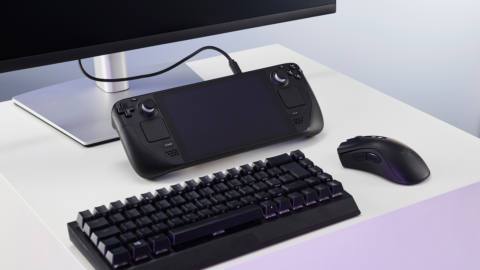Just a few weeks ago we reported on rumours that there could be a Legion Go Lite and a Legion Go Gen Two approaching—that’s two new Legion Go handhelds. Now, however, there’s reason to believe there might be three.
The reason being that Notebookcheck has discovered EEC filings (via VideoCardz) for a Legion Go S 8ARP1, 8AHP2, and 8ASP2—three separate models. There’s also speculation over what these enigmatic model names might mean, and they might hint at a mess of upcoming AMD Z2 processors spanning three different generations.
AMD’s Z1 Processors (the Z1 and the Z1 Extreme) adorn a couple of the best handheld gaming PCs today: the Asus ROG Ally and Lenovo Legion Go. The Z1 Extreme processor is, for all intents and purposes, the same as the mobile 7840U (Phoenix Point architecture) or 8840U (Hawk Point) processors, but made specifically for handhelds.
There’s therefore been a lot of excitement surrounding possible AMD Ryzen Z2 or Z2 Extreme processors, primarily because these could boast next-gen Strix Point architecture that we already find in some gaming laptops. Along with Intel’s new Lunar Lake processors, Strix Point chips provide improved performance and battery life compared to previous-gen processors, and many are hoping they will soon find their way into new handheld devices.
Notebookcheck rightly points out that the listings for these three new Lenovo Legion Go handhelds could very likely refer to different AMD architectural generations being used in their different AMD Z2 processors. The “8AHP2” could refer to a Legion Go with a Hawk Point processor—possibly functionally equivalent to the Z1 Extreme processor that’s found in the current-gen Legion Go—and “8ASP2” could refer to a Legion Go with a new Strix Point Z2 processor.
As for “8ARP1”? I’m not sure. Notebookcheck suggests that it could be powered by an AMD Rembrandt APU. However, Rembrandt processors are pretty old now, and I’m not so sure “RP” would be chosen for this codename—where’s the “P” in “Rembrandt”? There is reason to think this might make sense, however, as we’ll see.
The question is why we’d think all of these AMD processors of different generations that will supposedly feature in Lenovo Legion Go handhelds are Z2 processors. The answer comes from another leak, this time from well-known Billibilli forum leaker Golden Pig (via VideoCardz).
According to Golden Pig, there will be a few Ryzen Z2 series processors, with the top-end Z2 Extreme featuring 16x RDNA 3.5 CUs (four more than the Z1 Extreme’s 12 CUs), this being essentially the same as the Strix Point 890M mobile GPU.
Z2E 12CU RDNA3.5 (Strix Point)Z2 12CU RDNA3 (Hawk Point)Z2G 12CU RDNA2 (Rembrandt)https://t.co/4DCn5PTeTYOctober 22, 2024
In addition, AMD’s also expected to launch a Z2 (non-Extreme) APU using Zen 4 architecture with RDNA 3 graphics and a Z2G APU using Zen 3+ architecture and RDNA 2 graphics.
Put two and two (or perhaps what feels more like 50 and 50) together and you have three AMD Z2 processors spanning three different architectural generations, and three upcoming Lenovo Legion Go handhelds with codenames that seem to refer to these very same architectural generations.

Best handheld gaming PC: What’s the best travel buddy?
Steam Deck OLED review: Our verdict on Valve’s handheld.
Best Steam Deck accessories: Get decked out.
Steam Deck battery life: What’s the real battery life?
If these leaks are correct, this would suggest that there will be three AMD Z2 handheld processors, each one using a different architectural generation of processor, and three different upcoming Legion Go handheld gaming PCs that will each house a different one of these Z2 processors.
Whew, that was a lot. But once you’ve sifted through the ridiculous naming schemes it’s quite simple. And given there’s rumour of a Legion Go Lite—and even possible pictures of it—it would make sense for there to be one sporting a current-gen (Hawk Point) or older-gen (Rembrandt) APU.
As for why AMD would call these older-gen processors “Z2”, well, it has to call them something, doesn’t it? And technically the Z1 Extreme is Phoenix, not Hawk Point, even if they are essentially functionally equivalent.
The joy of naming schemes, eh? Kinda gives me flashbacks to AMD’s wheel-o-laptop decoder chip…






